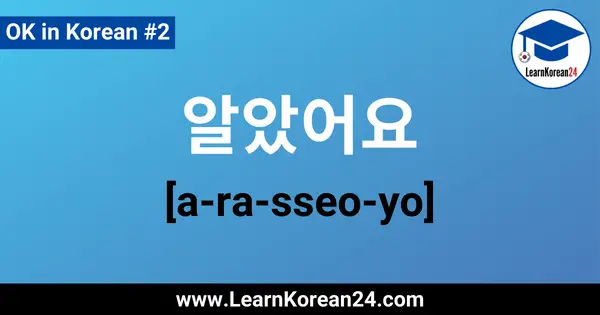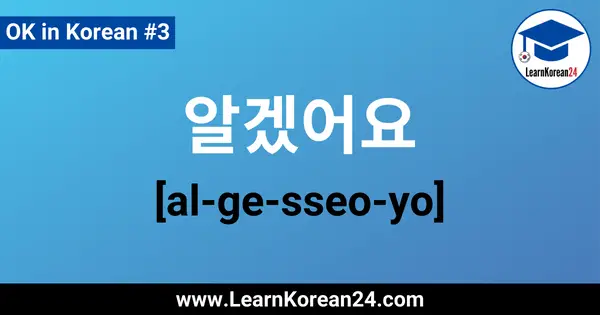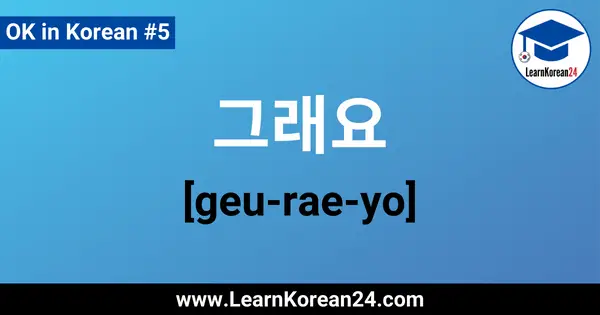Learn How To Say OK in Korean
In this short lesson, you will learn how to say “OK” in Korean. Before we start the lesson, it’s important to note that in English, when you say “Ok/Okay”, it can mean many different things. It can mean agreement or acceptance (“Ok, I’ll tell him“), that something is satisfactory (“The food was OK“), ‘yes’, and ‘I know’. In Korean, these ways to say OK all use different words and so it can be confusing which word you should use. But don’t worry. We will show you the different ways to say OK in Korean below.
Related: How To Say “I Know” In Korean
How To Say Ok In Korean
1. 괜찮아요 [gwaen-cha-na-yo]

The most common way to say OK in Korean is 괜찮아요 [gwaen-cha-na-yo]. This means ‘OK’ in the sense of ‘satisfactory’ or ‘not bad’. This is the adjective 괜찮다 (to be okay) conjugated into the present tense with the polite ending 요 attached. As such, 괜찮아요 is the polite way to say OK in Korean, and can be used in most situations.
The formal way to say OK in Korean is 괜찮습니다 [gwaen-chan-seum-ni-da] and the informal way to say OK in Korean is 괜찮아 [gwaen-cha-na].
Here are some example sentences using 괜찮아요 (OK):
A: 괜찮아요? [gwaen-cha-na-yo] = Are you okay?
B: 네, 괜찮아요. [ne, gwaen-cha-na-yo] = Yes, I’m okay.
A: 영화가 어땠어? [yeong-hwa-ga eo-ttae-sseo] = How was the movie?
B: 괜찮았어. [gwaen-cha-na-sseo] = It was okay.
A: 죄송합니다. [jwe-song-ham-ni-da] = I’m sorry.
B: 괜찮아요. [gwaen-cha-na-yo] = That’s okay.
2. 알았어요 [a-ra-sseo-yo]

알았어요 [a-ra-sseo-yo] means “I knew it” or “I got it.” in Korean and can be used when you want to say “OK” in the sense of “OK, I got it.” or “OK, I know/see”. 알았어요 [a-ra-sseo-yo] is the polite form. If you watch Korean dramas, you probably hear “Arasseo” a lot in conversation. “Arasseo” is the informal way to say “I knew it/got it” in Korean (알았어).
Here are some example sentences using this way to say OK in Korean:
A: 오늘 저녁에 늦지 마! [o-neul jeo-nyeo-ge neut-ji ma] = Don’t be late tonight!
B: 알았어요, 엄마. [a-ra-sseo-yo eom-ma] = OK, mum.
A: 이거 민호한테 줄래? [i-geo min-ho-han-te jul-lae] = Can you give this to Minho?
B: 알았어. [a-ra-sseo] = OK.
A: 방금 이메일 보냈어요. [bang-geum i-me-il bo-nae-sseo-yo] = I just sent you an email.
B: 알았어요. [a-ra-sseo-yo] = OK.
3. 알겠어요 [al-ge-sseo-yo]

A softer way to say ‘arasseo’ is to use the expression 알겠어요 [al-ge-sseo-yo]. This is the verb 알다 (to know) with 겠 attached, which roughly translates as ‘guess’. So, 알겠어요 literally means ‘I guess I know’, but is used when you want to say “Ok, I got it.” in a soft and polite way.
4. 좋아요 [jo-a-yo]

좋아요 [jo-a-yo] literally means “It’s good”, but is used to when you want to say “OK” to accept someone’s suggestion. It’s like saying “OK, sounds good.” in English. The informal form is 좋아 [jo-a] and the formal form is 좋습니다 [jo-sseum-ni-da]. Let’s look at some example sentences.
A: 우리 내일 산에 갈까요? [u-ri nae-il sa-ne gal-kka-yo] = Shall we go to the mountain tomorrow?
B: 좋아요. [jo-a-yo] = OK.
A: 이거 먹을래? [i-geo meo-geul-lae] = Would you like to eat this?
B: 좋아. [jo-a] = OK.
5. 그래요 [geu-rae-yo]

Another way to say OK in Korean is 그래요 [geu-rae-yo]. 그래요 is used when you want to say “OK” or “Sure” to accept someone’s proposal or request. Let’s look at some example sentences.
A: 수민 씨, 이거 좀 들어 주세요. [su-min ssi, i-geo jom deu-reo ju-se-yo] = Sumin, please hold this for me.
B: 그래요. [geu-rae-yo] = OK.
A: 3시에 만날까요? [se-si-e man-nal-kka-yo] = Shall we meet at 3?
B: 그래요. [geu-rae-yo] = OK.
Related Lessons
Thanks for reading. I hope you found this lesson OK, OK? ㅋㅋ Before you go, here are some more useful lessons you should check out:
Have A Nice Day In Korean
Delicious In Korean
I Don’t Understand In Korean
You’re Welcome In Korean


